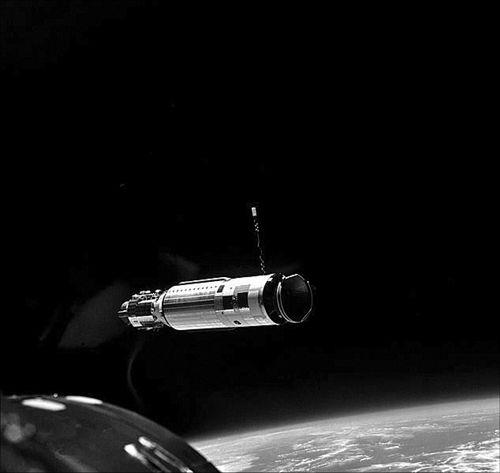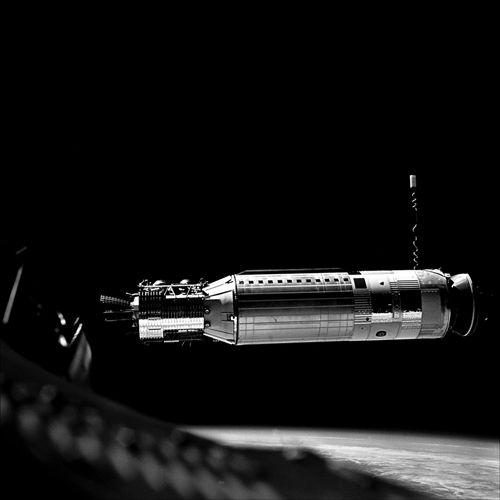Neil Armstrong: A Life of Flight (18 page)
Read Neil Armstrong: A Life of Flight Online
Authors: Jay Barbree
Tags: #Science, #Astronomy, #Biography & Autobiography, #Science & Technology

He turned back to his duties and in less than seven minutes they were over the Houston area. He and Dave struggled to see their homes—too many clouds; not enough time to look.
It was 1 hour and 34 minutes into their flight. It was time for their next burn and Neil fired
Gemini 8
’s thrusters. They burned for five seconds, and the spacecraft’s orbital speed decreased slightly. But there was suddenly another problem! When the firing was completed, it took a few seconds for the residual thrust to clear, which varied the computer readings making it difficult to tell the exact change in orbital speed.
The computer people on the ground went off to work on the problem while the crew, for the next 47 minutes, operated
Gemini 8
’s computer in “catch-up mode.” Their duty was to continue the chase.
Gemini 8
was now below their Agena. That meant their spacecraft was traveling a shorter distance than their target, moving faster around Earth.
Neil and Dave were trying to lock-on its radar with the Agena’s transponder. The transponder had one job—answer the inquiring signal from
Gemini.
The terminal phase could not begin until they had a solid radar lock, and at 3 hours, 48 minutes, and 51 seconds into the flight, Mission Control was standing by to talk to the crew over the Tananarive tracking station.
Tananarive was located in the Malagasy Republic on the island of Madagascar off the east coast of Africa, and astronaut Jim Lovell raised the astronauts asking, “Do you have solid radar lock on the Agena?”
“That is affirmative.” Neil delivered the good news. “We have solid radar lock. Just a second and I will give you our current range.”
“Roger.” Lovell smiled.
“We are indicating a 158-mile range and an elevation of about 4 degrees.”
“Roger, sounds good and I’m seeing about three minutes and nine seconds until your burn.”
Over Tananarive Neil Armstrong was ready to fire his thrusters again. The orbit they had been moving through to catch up with its target was elliptical, and Armstrong nosed down his spacecraft and triggered his rockets. The firing circularized their orbit in a more precise plane with the Agena, and
Gemini 8
continued to close on its target. Neil and Dave had radar giving them range and position and they knew they would see the Agena at some point, but just when and where?
Then at 4 hours and 48 minutes into the mission Neil told them to stand by: “Okay, we’ve got a visual on the Agena at 76 miles,” he reported. “At least we have some object in sight. Or something that looks like it could be the Agena.”
“Understand a visual Agena, or Sirius, 76 miles,” acknowledged Houston.
“Yeah,” Neil replied. “It could be a planet.”
They moved ahead. Not sure they were seeing the Agena, but sure it was out there. They wanted to be in the dark for most of their approach until roughly ten miles out. That’s when Agena would reenter daylight and they could see it like a huge beacon against the black of the universe and Neil called: “Okay, we could have a solid visual on the Agena,” he told them. “Range is 56 miles. I’m taking a second look at it with the sextant.”
Then, silence. Fifteen minutes passed with no word from the crew. Some flight controllers were getting edgy but spacecraft communicator Jim Lovell was hesitant to contact the astronauts because this was one of the most difficult parts of the flight.
“Both crewmen are quite busy,” Lovell explained. “Dave is doing the math for the final approach and Neil is controlling the thrusters.”
No sooner than Lovell had concluded his report, Neil was back. “Okay, going into darkness at—let’s see, 05:02. We lost a visual on the Agena, and I had the ACQ [acquisition] light up right away. Range was forty-five miles.” He paused. “It’s very hard to see, but it looks like a sixth-magnitude star, I’d say.”
Flight controllers looked at one another as
Gemini 8
moved deep into the night side of Earth. The astronauts’ rendezvous and docking mission so far was pretty much peaches and cream.
Neil and Dave’s hunt for their Agena quarry had gone better than most would have predicted and, with the distance between the two craft closing fast, they set up for their final push.
“Okay, I’m going to start braking down a little bit very shortly,” Neil told Dave. “Are we inside 15K?” he asked.
“Inside 15K,” Dave assured him (15K is 15,000 feet or 2.84 nautical miles).
The
Coastal Sentry Quebec
tracking ship below told Mission Control
Gemini 8
’s range from its Agena target was now about 14,000 feet and several flight controllers raised their thumbs indicating that things were going along very well.
Agena’s light! It was straight ahead. Neil and Dave were fixed on its glare and Neil Armstrong kept his spacecraft closing the distance between the two at the glacial pace of about five feet per second, a speed any runner could best.
It was
the
critical point of the mission. Agena was so close. No time to lose concentration. Move in slowly and surely; put on the brakes at the precise time for station-keeping.
The maneuvers were at their most critical and demanding, but that didn’t stop Houston from asking for more talk from the crew. “The pilots are acting extremely ‘ho-hum,’” Mission Control told the
Coastal Sentry
. “Could you urge them to say a bit more about their situation?”
They were back on the day side, but Neil and Dave weren’t talking, they were concentrating. They were making ever so sure they were crossing all their Ts and dotting all their Is, since in orbit they had been very much alone in their work. They weren’t about to screw things up now by losing focus in banter with the ground. Not when … Suddenly, they were no longer alone!
It was right there!
Sitting right in front of
Gemini 8
was Agena. It was big. It was bold. It was beautiful. It was a product of Earth. Neil smiled at Dave. “That’s just unbelievable,” he said. “Unbelievable!”
“I can’t believe it, either,” Scott agreed, hitting Armstrong on the shoulder and saying, “Outstanding job, Coach!”
“It takes two to tango,” Neil assured Dave.

The Agena target a football field away. (NASA)
They had completed their fourth run through the night side and they could now see a crack in the darkness followed by a breath of light that grew rapidly into a riotous shout of color, a vivid, glowing day.
The sun stabbed across half of the sleek and long Agena rocket stage. It was suspended in the universe’s total blackness. Earthglow reached up with its warm blues and whites to welcome Neil and Dave. The crew of
Gemini 8
felt tremendous pride in the thousands who had built and launched the Gemini spacecraft and the Agena—who had sent them on this hunt and chase. They were grateful to, and honored by all those hands at the Cape, in Mission Control, in the Agena and Gemini plants that had made it possible.

Neil and Dave’s Agena target 150 feet away. (NASA)
But the biggest prize was still out there—the docking—and suddenly they heard Hawaii calling: “
Gemini 8
, this is Hawaii CapCom.”
Dave Scott, knowing the hard work Neil had put into pulling off the rendezvous, smiled and said, “You tell them.”
Armstrong nodded. “Aloha, Hawaii, we’re station-keeping.”
A cheer came up from the station and Neil continued, telling Hawaii and Jim Lovell in Mission Control that the Agena looked fine, the antennas were all in the proper position, and TDA (The Docking Adapter) hadn’t a scratch, with no apparent worse for wear. They were in good shape for docking.
The two astronauts were pleased to have Jim Lovell as CapCom. He, along with Frank Borman, had flown the last Gemini three months ago—logged two weeks aboard
Gemini 7
, and Lovell certainly had solid knowledge of the ship they were flying.

Station-keeping with a perfect Agena shining in the glow of the Pacific. (NASA)
They flew away from Hawaii again, but this time they had a wingman. They would fly in formation with the Agena across the Pacific and South America and on the other side of the continent they would find their next contact with Earth, the tracking ship
Rose Knot Victor.
NASA commentator Paul Haney told the public and the media, “The flight plan from here calls for the actual docking to take place over the
Rose Knot Victor
parked down off the coast of South America. The
Rose Knot Victor
is to acquire the spacecraft at 6 hours 32 minutes into the flight. We presently show 6 hours 8 minutes into the flight.”
Twenty minutes. That’s what he had and Neil told himself to review learned procedures, to review all he had been told by Wally Schirra and Tom Stafford who, only three months earlier, had flown the first rendezvous, making up much of it as they flew
Gemini 6
right up to
Gemini 7
—putting on the brakes, station-keeping, doing fly-arounds, circling each other in a series of figure eights, and closing to within six to eight inches before backing off and flying in again. Now it was Dave Scott and Neil Armstrong’s assignment to finish the job.
Were they ready? You betcha!
Neil and Dave began inching toward their target.
Gemini 8
had already moved to within 80 feet of the Agena and as they sped across the Pacific, Neil Armstrong fired his rocket thrusters as Dave Scott chanted distances and elevations. Neil’s firing of the thrusters closed the distance between his spacecraft and the passive Agena an inch at a time. Closer and closer they came to the huge docking adapter on the back end of their target rocket, lining up perfectly with the funnel-shaped adapter. When they were within 2 feet, Neil put on the brakes. He matched
Gemini 8
’s speed and position precisely with the Agena’s. They were in every sense one. They just hadn’t docked.
Gemini 8
’s astronauts were peering down their spacecraft’s nose into the docking ring. The sensors and latches that would secure their docking waited. Then they heard, “
Gemini 8
this is
Rose Knot Victor
.”
“… about two feet out,” Neil told the tracking ship quietly.
“Roger, stand by for a couple of minutes here.”
“Is he docked?” Mission Control asked.
“Negative, he’s not docked yet,”
Rose Knot Victor
told Houston, and then the tracking ship monitored and studied all the Gemini and Agena systems.
“Okay
Gemini 8
, it looks good here from the ground. We’re showing column rigid, everything looks good for docking.”
“Roger.”
Neil Armstrong slowly nudged
Gemini 8
’s nose into Agena’s adapter. Sensors recognized the spacecraft. The crew heard and felt electric motors grinding. The latches clicked home.
Gemini 8
and the Agena were one.
“Flight,” Neil spoke directly to Flight Director John Hodge. “We are docked! It was really a smoothie.”
In Houston Mission Control pandemonium broke loose: backslaps, handshakes, cheering, whistling, shouting, applause, and tremendous grins as cigars were given out by Deke Slayton. The control center flashed the news across NASA’s tracking network, and throughout most of the world. American space flyers had achieved the first docking between two spacecraft.
